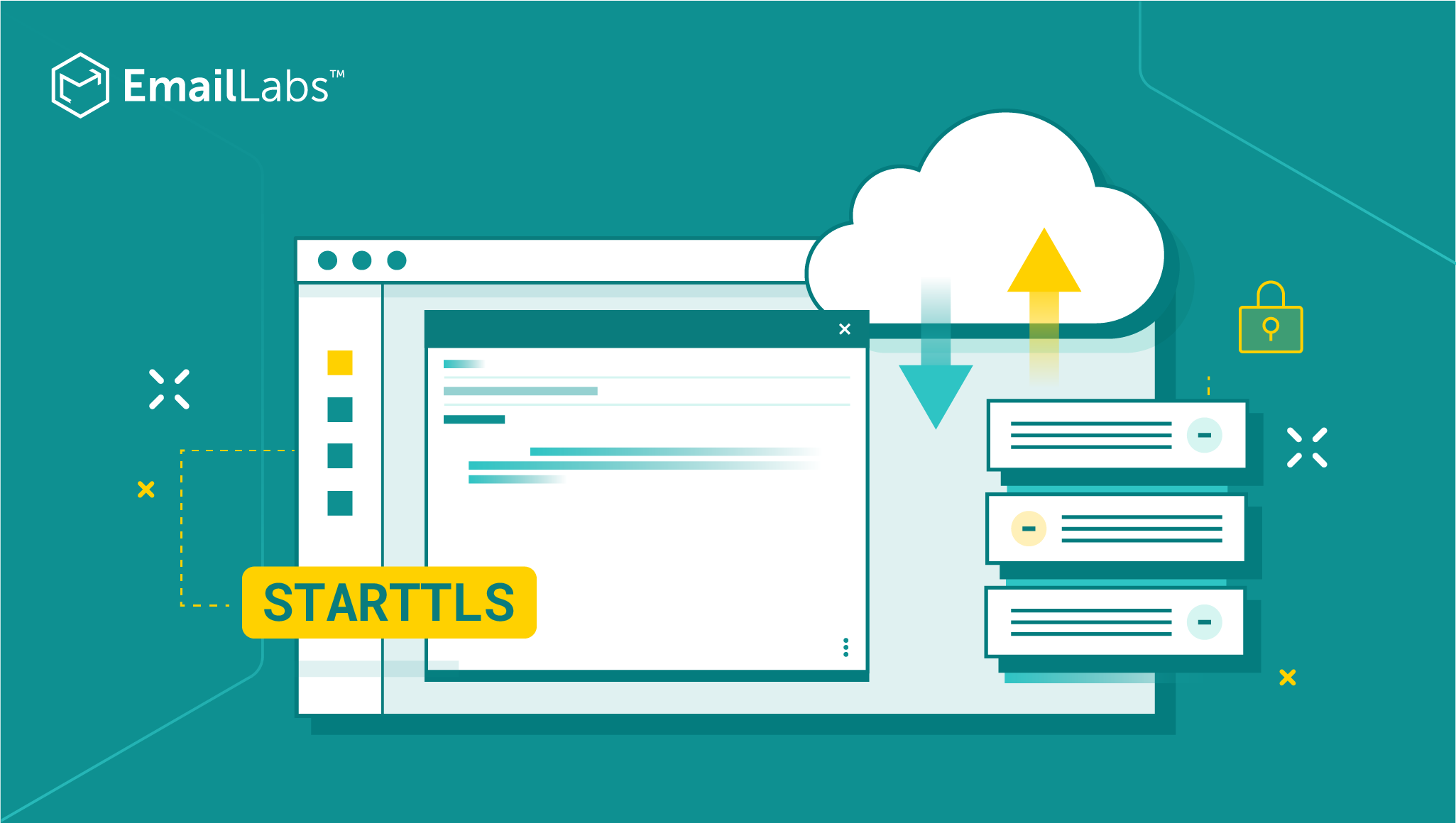
The significance of email protection and data security is growing exponentially in today’s digital world, with StartTLS emerging as a key player in this arena. As an encryption protocol extension, StartTLS offers users a unique method for dealing with insecure connections, ensuring that sensitive information is safeguarded during transmission.
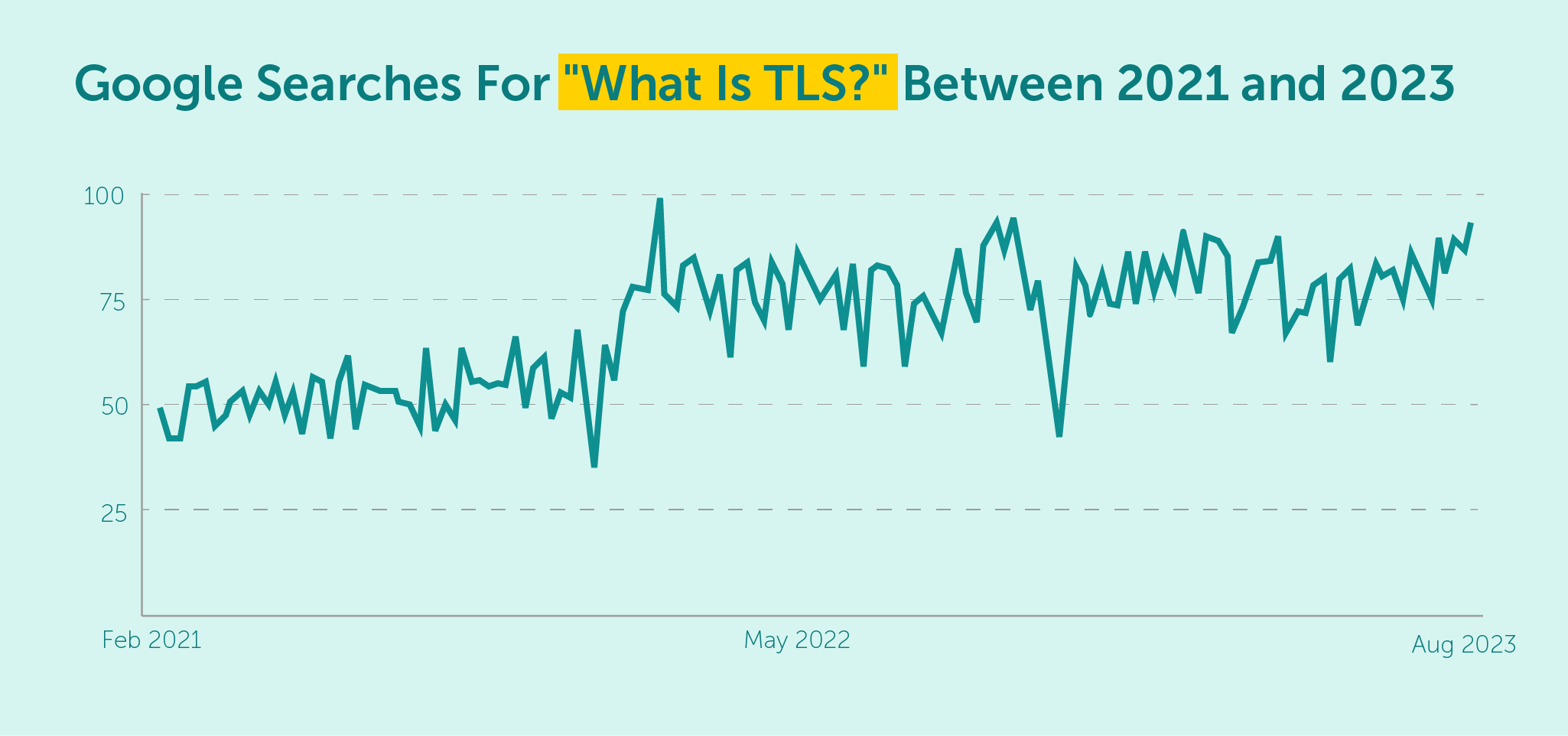
Transport Layer Security (TLS) and its predecessor, Secure Sockets Layer (SSL), form the foundation of modern encryption protocols. These technologies are designed to establish a secure connection between two computers over the internet, protecting data from potential interception or unauthorized access.
StartTLS builds upon these existing encryption protocols, introducing a new approach to handling insecure connections and providing additional layers of security for email clients and servers.
Below, we will present the importance of StartTLS for any email client, exploring how it functions and why it has become an essential component in email security. We will also examine how StartTLS compares to other encryption methods and discuss the benefits of implementing this protocol extension in your email communication systems.
StartTLS is a command that plays a crucial role in securing email communications. This command is issued by an email client or server when it initially connects with another server or client.
The primary objective of StartTLS is to request an upgrade from the existing insecure connection to a secure one using the TLS or SSL protocol. By employing this approach, both parties involved can smoothly transition from plain-text connections to encrypted ones without the need for opening new ports or modifying any settings.
Furthermore, StartTLS offers adaptability in terms of compatibility with different systems and applications. This flexibility stems from its ability to initiate encrypted connections on the same port as the original insecure connection. As a result, StartTLS simplifies the process of upgrading to a secure connection without causing disruptions or requiring additional configurations.
The TLS protocol has replaced SSL as the go-to option for encryption, providing a more robust and reliable process. With its enhanced security features, TLS ensures that sensitive data transmitted via email remains confidential and well-protected against unauthorized access.
Consequently, when a server or client supports encrypted connections, they can efficiently manage internet traffic with increased security, effectively safeguarding sensitive information.
Maximize your email deliverability and security with EmailLabs!
There are two main types of TLS implementation in email transmission: Opportunistic TLS and Forced TLS. Both of these methods aim to provide secure connections between email clients and servers, but they differ in their approach and implementation.
Opportunistic TLS refers to the use of the StartTLS command during the initial connection between two parties. When an email client or server connects to another server or client, it issues the StartTLS command to request an upgrade from an insecure connection to a secure one using SSL/TLS protocols.
If both parties support encryption, they will seamlessly upgrade their connection, ensuring that the data transmitted is protected from potential interception. If not, they will establish a plain-text transmission.
On the other hand, forced TLS takes a more rigorous approach to establishing secure connections. In this method, the connection must be secured from the very beginning without asking a server about its compatibility. If a server is incompatible, the transmission will not be established.
Most modern and secure systems prefer Opportunistic TLS over Implicit TLS due to its flexibility and compatibility with a wide range of services. Opportunistic TLS allows for a more straightforward transition from insecure to secure connections without causing disruption in communication or requiring additional configuration changes.
Cyber threats are increasingly prevalent, and due to this, the importance of safeguarding sensitive information cannot be overstated.
StartTLS plays a critical role in this aspect by offering an encryption method that can be easily implemented in email clients and servers, ensuring that confidential data remains secure throughout its journey.
The Simple Mail Transfer Protocol (SMTP) is the standard protocol for email transmission. When it was initially designed, SMTP only supported plain-text connections. Because of that, email transmissions were left vulnerable to interception by malicious parties who could exploit this weakness to access sensitive information.
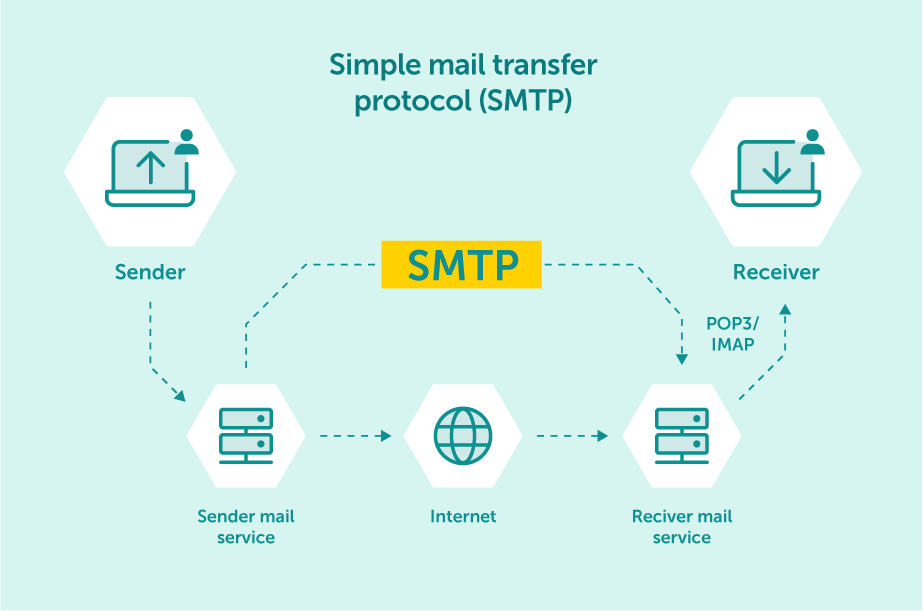
SMTP is a fundamental protocol used in email communication. Most likely, it’s behind the emails we send and receive each day.
This lack of security posed significant risks to both organizations and individuals, as it exposed their confidential data to potential breaches.
Recognizing the need for enhanced security, StartTLS was introduced as a solution to upgrade insecure SMTP connections. By incorporating StartTLS into email clients’ and servers’ functionality, these systems can now seamlessly switch from plain-text to encrypted connections without disruption. This encryption process ensures that sensitive information within emails remains protected against unauthorized access or eavesdropping during transmission.
In short, StartTLS has revolutionized email security by providing an efficient and accessible encryption method for email clients and servers. By upgrading SMTP connections from plain text to secure encrypted ones, the safety of sensitive information is significantly enhanced.
Understanding the process behind StartTLS can help us unveil how it enhances email security.
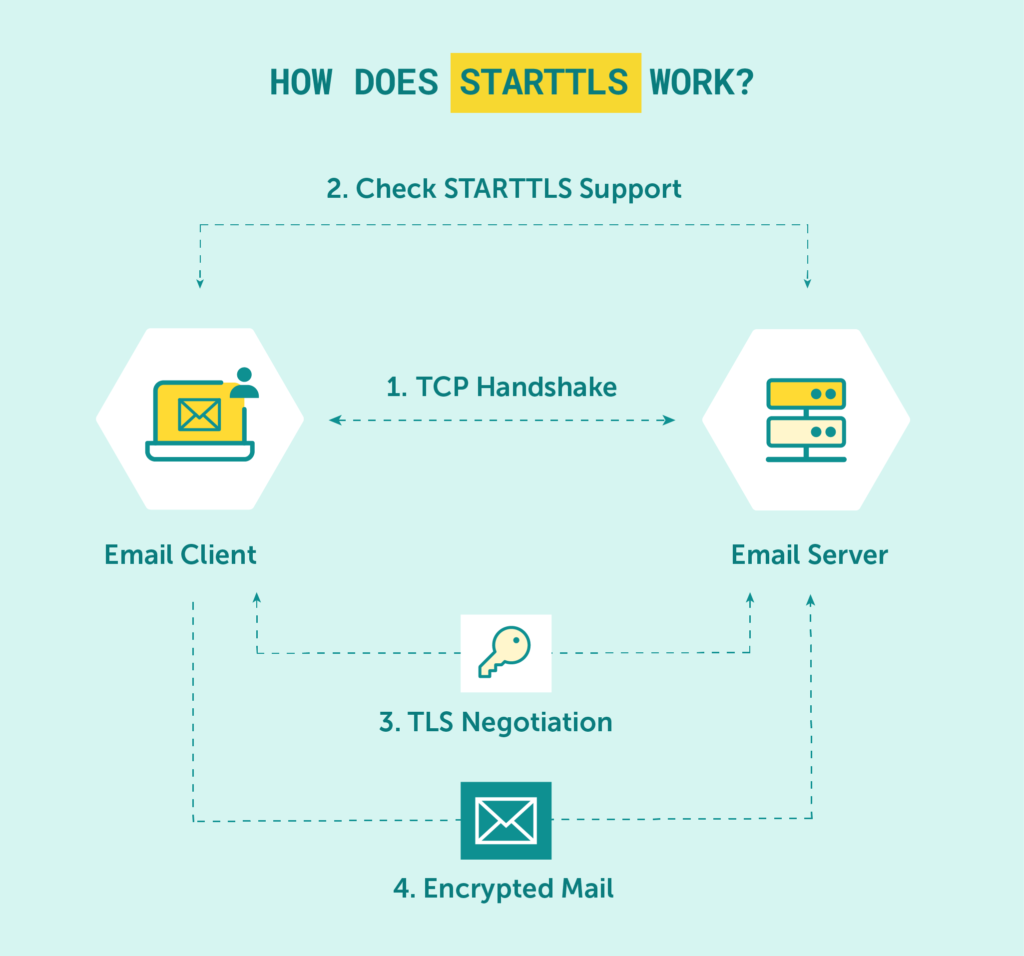
This notification process begins with the Transmission Control Protocol (TCP) handshake to help the email client and server identify each other.
As internet users become increasingly aware of the importance of data protection, more and more services support encrypted connections. Most modern email clients and servers offer secure connections using SSL/TLS protocols or the StartTLS extension, reflecting the evolving landscape of online security.
However, it is not uncommon for older systems to lag in their support for encryption or to offer only limited encryption options. This situation can pose a significant risk, as these outdated methods may leave users vulnerable to cyber-attacks and data breaches.
It’s essential to ensure that your email client or server supports up-to-date encryption methods like StartTLS to adequately protect confidential information during email submission and delivery.
EmailLabs offers a fast and secure email service that puts the security of your business as a top priority. Besides Transport Layer Security (TLS) encryption, it uses other authentications, such as SPF, DKIM, and DMARC.
On top of that, EmailLabs’ infrastructure resides in a state-of-the-art data centre meticulously designed to ensure the utmost safety and security when it comes to data storage and processing. This modern facility adheres to the most stringent industry standards, guaranteeing that your valuable information is in good hands.
EmailLabs infrastructure expansion – facilitations for Microsoft Azure users
Contact us to learn more about how we can help your business succeed!
Maximize your email deliverability and security with EmailLabs!
To verify whether an email server or client supports StartTLS, you can perform a simple test. By connecting to the server’s IP address on the standard port for SMTP submission (port 587), you can issue the StartTLS command manually.
If the server supports StartTLS, it will respond with a confirmation message, and the client can proceed with the encryption process.
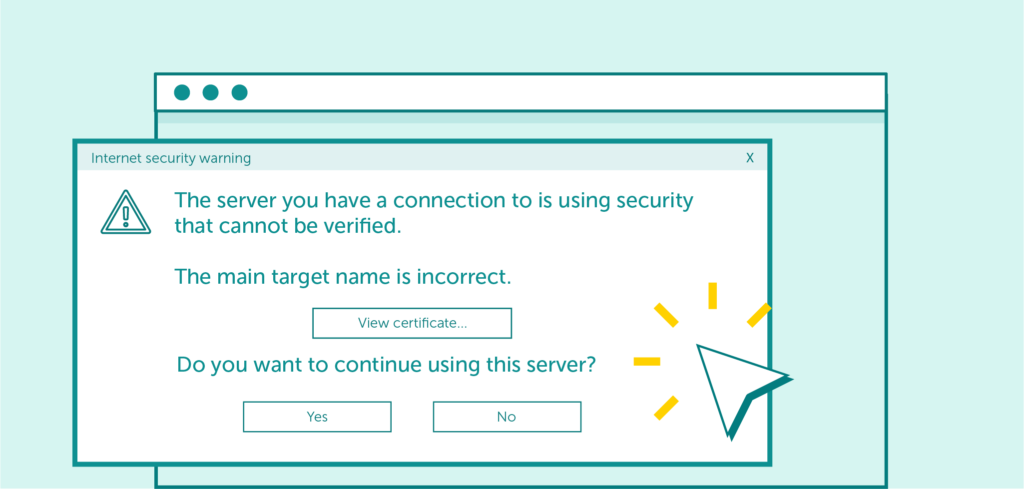
You may see such a message in your inbox when there is a problem with data encryption.
StartTLS has become an indispensable tool in fortifying email communications, allowing users to maintain privacy and protect their sensitive data. By issuing the StartTLS command during the initial connection phase, clients and servers can easily switch from insecure connections to encrypted ones, ensuring a safer and more reliable exchange of information over the internet.
With most services supporting encryption protocols like SSL/TLS and StartTLS, it’s easier than ever to maintain email security and keep confidential information safe.
Ensuring that your email client or server supports the latest encryption methods can make all the difference in safeguarding vital information and maintaining a strong online security posture.
We live in a world where your customers switch seamlessly between laptops, smartphones, and tablets. They navigate a complex digital ecosystem – checking emails, using mobile apps, and reacting...
We are delighted to announce that Vercom S.A., the company behind the EmailLabs project, has successfully completed the ISO 22301 certification process. This significant achievement underscores our commitment to...
EmailLabs, as part of the Vercom group, proudly announces its full commitment to aligning its ICT services with the latest cybersecurity standards. In response to dynamically changing regulations, the...
We are pleased to announce that MessageFlow, a product from the Vercom S.A. group, has received the prestigious CSA (Certified Senders Alliance) Certification. This recognition not only underscores the...
IT & Tech, Pytania i odpowiedzi, Technical
When an email travels from sender to recipient, it passes through several critical components of email infrastructure. At the heart of this journey sits the Mail Transfer Agent (MTA)...
Best practices, Deliverability, Google and Yahoo's Requirements, Pytania i odpowiedzi
The world of email marketing is constantly evolving, and leading mail service providers – Gmail, Yahoo, Microsoft, and Apple – regularly update their guidelines for senders. In recent years,...
Gmail, Google and Yahoo's Requirements
You might have noticed a new item in your Gmail sidebar recently – the “Manage subscriptions” tab, often flagged with a blue notification dot. While Google announced this feature...
IT & Tech, Pytania i odpowiedzi, Technical
When an email travels from sender to recipient, it passes through several critical components of email infrastructure. At the heart of this journey sits the Mail Transfer Agent (MTA)...
Best practices, Deliverability, Google and Yahoo's Requirements, Pytania i odpowiedzi
The world of email marketing is constantly evolving, and leading mail service providers – Gmail, Yahoo, Microsoft, and Apple – regularly update their guidelines for senders. In recent years,...
Gmail, Google and Yahoo's Requirements
You might have noticed a new item in your Gmail sidebar recently – the “Manage subscriptions” tab, often flagged with a blue notification dot. While Google announced this feature...
IT & Tech, Pytania i odpowiedzi, Technical
Efficient email communication isn’t just about sending messages — it also involves integrating email functionality into your business systems and applications. Email APIs (Application Programming Interfaces) serve as the...
One of the most important yet often underestimated elements in shaping a company’s brand perception is the transactional email. In e-commerce, the design of such messages must be carefully...
Google and Yahoo's Requirements, Yahoogle
2024 brought fundamental changes to email marketing, introducing new, stringent requirements for senders. Since February 1, 2024, Google and Yahoo have started enforcing new deliverability rules, primarily targeting bulk...
We live in a world where your customers switch seamlessly between laptops, smartphones, and tablets. They navigate a complex digital ecosystem – checking emails, using mobile apps, and reacting...
Are your campaigns not engaging all recipients as you expect? Do they fail to open your emails or click on links, lowering your campaign effectiveness and email marketing ROI?...
Gmail, Google and Yahoo's Requirements, Updates
Gmail’s educational phase has ended. Google has officially announced the start of a new phase – the Gmail Enforcement Phase – which begins to take effect in November 2025....